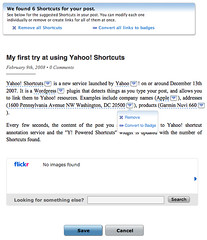Yahoo! Shortcuts is a new service launched by Yahoo! on or around December 13th 2007. Yahoo! Shortcuts make it easy for bloggers to link the content in their blog posts to Yahoo! resources, such as maps, products for sale or stock quotes.
The interesting part of Yahoo! Shortcuts is in the WordPress plugin provided to insert these links. The plugin detects things as you type your post, and allows you to link them to Yahoo! resources. In this page, all these dotted underline links are Yahoo Shortcuts you can try out by passing your mouse pointer over. Examples include addresses (1600 Pennsylvania Avenue NW Washington, DC 20500), products (Garmin Nuvi 660), and companies (Apple).
Whenever a “Shortcut” is found, the Y! Powered Shortcuts widget is updated with the number of Shortcuts found. Also, the text of the shortcut is markup like: <span id="lw_1202511969_3" class="yshortcuts">Apple. The last digit of the id seems to be the number of the shortcut, and the number “1202511969” seems to be an id that is unique to the post. It’s worth noting the cryptic nature of these tags: there seems to be no way to tell that a particular shortcut is an address or product or company name.
I also noticed that it seems that when an entity like Apple is mentioned several times, it is only detected once. I guess that this is to avoid cluttering the post with tons of shortcuts.
The next step consists in reviewing the post. For each Shortcut detected, it is possible to remove it, convert it to a badge or keep it as a link (default). A badge means that the Yahoo! content will be embedded in the page itself. A link means that the Yahoo! content will appear when the link is hovered.
I have to say I’m quite impressed with the annotation technology. “999 Mission, San Francisco” is not detected, but “999 Mission Street, San Francisco” is. “123 Mission St, San Francisco” is as well. There seems to be support for detection in other languages as well: 150 rue saint-jacques, paris was detected correctly for instance. I imagine that this technology is the same one I noticed Yahoo uses in Yahoo! Mail to detect emails, phone numbers, addresses, events, etc. The FAQ also mentions that there are ways to improve the chances of the service detecting some objects, which gives credit to my “plain old english formats” theory (more on this hopefully in a coming post).
One current limitation of this technology is the detection of the relations between individual pieces of data. For instance, in Yahoo! Mail, if I have a phone number next to a name next to an email, the email and the phones will be detected as individual pieces of data, and I will be given the possibility to create a new contact for the phone number or to add it to an existing contact. This would not be an issue with a microformatted hCard, but writing an hCard today requires more skills and time than writing plain english.
On the usability side, from a post writer standpoint, I think the whole thing is pretty well designed although it would be nice to have the post reviewing step integrated in WordPress editor (TinyMCE).
The main issue I see is from a reader standpoint: they have no choice as to what to do with the detected content. The only thing you can do with an address is to look it up on Yahoo! map or search related Yahoo! news. For a company, the only thing you can do it to look its stock performance on Yahoo! Finance or search for it, etc. But of course, that is the whole point for Yahoo!: drives more traffic towards Yahoo! properties. I also don’t know if the licensing terms allow the style to be changed (technically, it seems it’s possible since all the style-related files are part of the plugin), but I think that would be a necessity as these Yahoo badges may not satisfy everyone’s taste and may repel some users and change their perception of the quality of the blog.

